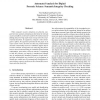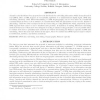15 search results - page 2 / 3 » Hiding data, forensics, and anti-forensics |
ACSAC
2003
IEEE
15 years 5 months ago
2003
IEEE
When computer security violations are detected, computer forensic analysts attempting to determine the relevant causes and effects are forced to perform the tedious tasks of find...
HICSS
2008
IEEE
15 years 6 months ago
2008
IEEE
The wealth of data available about a person’s computer activity is immense. Digital forensic sciences have progressed such that tools are readily available to recover deleted da...
MMSEC
2004
ACM
15 years 5 months ago
2004
ACM
This paper outlines a strategy to discriminate different ISO/ MPEG 1 Audio Layer-3 (MP3) encoding programs by statistical particularities of the compressed audio streams. We use ...
IJNSEC
2007
14 years 11 months ago
2007
The exponential growth of the Internet (WWW in particular) has opened-up several avenues for covert channel communication. Steganographic communication is one such avenue. Hiding ...
141
click to vote
MEDIAFORENSICS
2010
14 years 10 months ago
2010
A number of methods have been proposed over the last decade for embedding information within deoxyribonucleic acid (DNA). Since a DNA sequence is conceptually equivalent to a unid...


